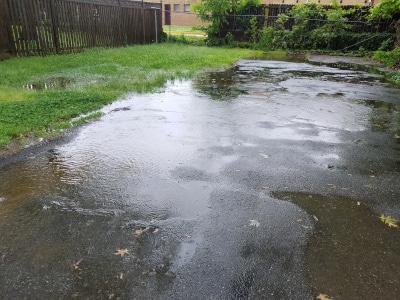
Driveway Drainage
Driveway drains, French drains, drainage swales, or creative grading are some potential fixes. Driveway drainage solutions vary depending on your property’s soil, terrain, and setup. Also, how your driveway is designed must be considered.
In the best-case scenario, all water should be directed away from the house, including correctly grading the driveway.
Direct Water Away from the Garage
Grade your driveway away from the house. A two percent pitch is a good number to aim for. This means that it will be graded at 1/4″ per foot. For example, the garage floor’s elevation will be 1″ higher than the elevation four feet away.
The grade can be as high as five percent if necessary. The area’s grade outside the garage is more important than the rest of the driveway since the car pulls in and out of the garage. This is often an area for parking, where a relatively level area is more comfortable than parking on a slope.
The balance of the driveway can have a grade ranging from two percent up to as high as twelve percent. The more level you can make the driveway, the better, but this is not always possible.

Sometimes driveways have a cross pitch so water does not run directly down the driveway. In these situations, the driveway is graded so that it flows towards the street and crosses the driveway. This creates a diagonal pitch.
Other grading issues and challenges might occur with your driveway drainage. Although it is easier and less expensive to address driveway drainage by grading the driveway properly, a drainage pipe is sometimes needed.
Land On Either Side Of The Driveway Slopes Towards The Driveway
Land on either side of the driveway may be pitched towards the driveway. One solution to this situation is to grade the land at the driveway edges away from the driveway. This meets the land sloping towards the driveway to create a drainage swale. A drainage swale is a pitched channel, typically located in the lawn and not very noticeable, which takes water away to a lower location.
If you don’t have the space for a swale, another alternative is to lay driveway drains at the driveway edge. These pipes and methods resemble French drains installed at house foundation perimeters. Typically perforated PVC pipe is used. Sometimes corrugated pipe with slits is another type of drainage pipe we use. The pipe should be pitched to bring the water to a good location. The drainage pipe should have filter fabric over it. We typically use the decorative stone to make the system look nice.
Your Home And Street Are At The Same Elevation
Sometimes it is difficult to get the correct driveway pitch due to a lack of change in elevation from one point to another. These situations are a little tricky and some creative grading must be done….and up and down type of affect in a couple of areas. Grading the driveway to a mid-point, where all areas are pitched to a central location is another option, and a driveway drain which visually looks like a grate is located there. Solid pipe is then connected to the interior of this drain, once again leading the water away.
Property Slopes Towards The House
In this case, a trench drain can be used where the driveway meets the garage. This long, narrow drain inlet gets slightly pitched in one direction. It then connects to a solid pipe which, as in the above scenarios, serves to lead water to a lower elevation on your property…one where it is OK to have water ending up there.
Trench drains can also be used if a steeply pitched driveway towards the street. The drain is placed at the end of the driveway right before it joins the road.
Many of these driveway drainage solutions can be used. It all depends on the individual situation, as many solutions for driveway drainage challenges exist.
Call All Seasons Waterproofing to Improve Driveway Drainage Today
If you need driveway drain installation and are in the Seattle-Tacoma area, please contact All Seasons Waterproofing to schedule a FREE Consultation and receive a written job cost repair estimate; email or call us today.
